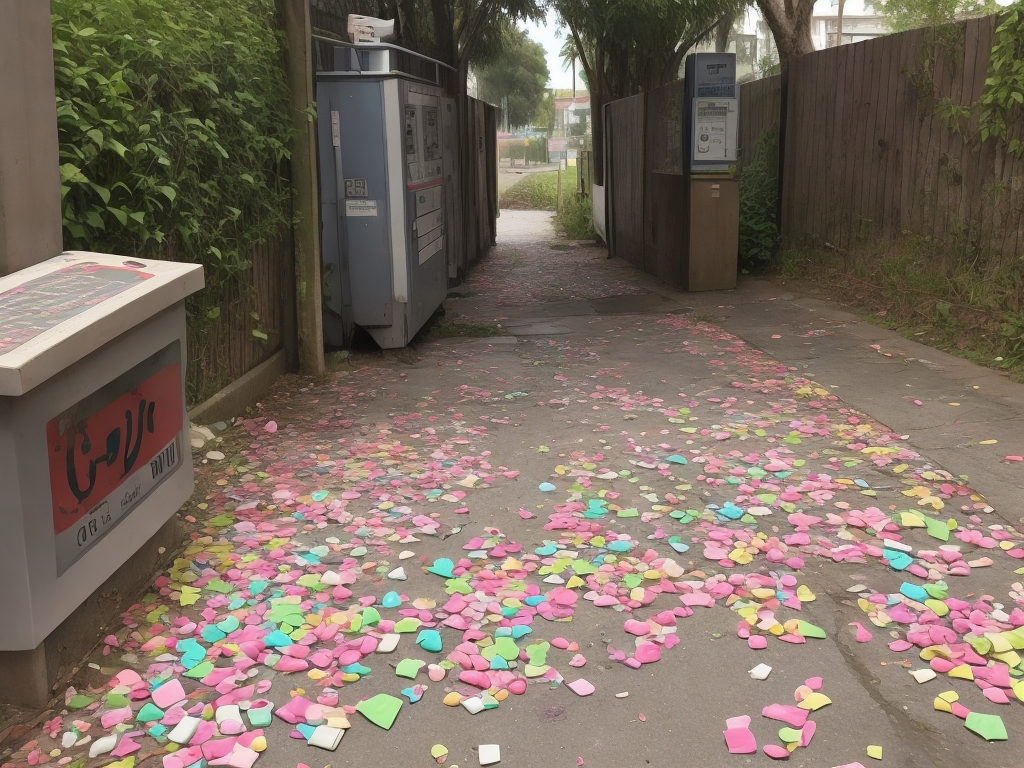
Gum litter is more than just a nuisance; it’s a hidden environmental menace. The seemingly innocent act of spitting out gum on the ground can have far-reaching consequences. Chewing gum contains synthetic polymers that don’t biodegrade quickly. When chewed gum is discarded improperly, it can stick around for years, defacing our streets and harming the environment.
A Visual Offense
One of the most evident consequences of gum litter is the unsightly mess it creates. Walk down any city street, and you’re likely to encounter sidewalks peppered with gum blotches. These colorful splotches may not be as glaring as other forms of litter, but they accumulate over time, tarnishing the aesthetic appeal of our communities.
Moreover, gum litter isn’t just a visual offense. It can become a health hazard when it traps dirt, debris, and bacteria, creating an unhygienic environment in our public spaces. As responsible adults, it’s our duty to educate our children about the importance of maintaining clean and visually appealing surroundings.
Environmental Impact
Beyond aesthetics and hygiene, gum litter poses a significant environmental threat. Chewing gum contains a synthetic rubber base, which is made from petroleum-derived materials. This means that the gum we chew and discard is essentially a form of plastic waste.
Plastic pollution is a global concern, and gum litter is an often-overlooked contributor to this problem. When gum ends up in waterways, it can harm aquatic life, as marine animals may mistake it for food or become entangled in it. Additionally, the chemicals used in gum production can leach into the soil and water, further polluting our ecosystems.
Teaching Kids About Responsible Gum Disposal
Now that we understand the gravity of gum litter, let’s explore how we can teach kids about responsible gum disposal:
Lead by Example
Leading by example is one of the most effective ways to teach children about responsible gum disposal and the importance of keeping our environment clean. Children are incredibly observant and tend to emulate the behavior they see in adults, especially their parents and caregivers.
When you make a conscious effort to dispose of your gum properly by using designated trash bins, you’re setting a powerful example for your children. They see that you not only talk about responsible behavior but also actively practice it. This hands-on demonstration sends a clear message that gum should never be discarded carelessly on the ground.
Engaging in this behavior presents an excellent opportunity to initiate a conversation with your kids. Explain to them why it’s essential to dispose of gum in the right way. You can discuss how improperly discarded gum can create a sticky mess on the streets and sidewalks, making public spaces look dirty and unappealing. This visual impact can help children connect their actions with the consequences they can see.
You can introduce the concept of environmental responsibility during these discussions. Emphasize that gum is made from materials that harm the environment, and by disposing of it correctly, they are contributing to the well-being of the planet.
Use Visual Aids
Visual aids, such as posters or videos, can serve as highly effective tools when educating children about the issue of gum litter. These visual aids can convey important messages in a visually engaging and memorable way.
Consider creating or using existing posters that depict the consequences of improper gum disposal. These posters can showcase images of gum-covered sidewalks, highlighting the unsightly mess that results from careless gum tossing. Such visuals can help children understand the real-world impact of their actions, making the issue more tangible and relatable.
In addition to showing the negative effects of gum litter, visual aids can also illustrate the positive impact of responsible gum disposal. You can create images or videos that depict people disposing of gum in designated bins, keeping public spaces clean and pleasant for everyone. This presents a contrast to the negative images and reinforces the idea that responsible behavior contributes to a cleaner environment.
When using visual aids, engage with your children in a discussion about what they see. Encourage them to ask questions and express their thoughts and feelings about the images or videos. This interactive approach can enhance their understanding and make the lessons more impactful.
Consider involving your children in the creation of visual aids. This hands-on experience can be educational and fun. They can draw their own posters or even make short videos on the topic. This creative involvement not only reinforces the message but also empowers them to take ownership of the issue.
Engage in Discussions
Engaging in open, honest conversations with your children about the environment and the repercussions of littering, including gum litter, is a crucial step in their education.
Begin these discussions by creating a comfortable and non-judgmental environment. Let your children know that they can ask questions and share their thoughts freely. Encourage them to express their opinions and feelings on these topics. By doing so, you create a space where they feel heard and valued, making them more receptive to the lessons you want to impart.
When discussing the environment, start with the basics. Explain what the environment is and why it’s essential to care for it. Use relatable examples, such as how clean parks and streets contribute to a pleasant community. Then, gradually introduce the concept of littering and how it harms the environment. You can describe how gum litter, in particular, can stick around for a long time and mar the beauty of public spaces.
Ask open-ended questions during these conversations. For instance, you can ask your children how they feel about seeing gum on the sidewalk or what they think happens to gum when it’s not disposed of properly. Encourage them to think critically and empathize with the impact of litter on the environment.
Share age-appropriate facts and stories to illustrate your points. You can narrate real-life examples of communities coming together to clean up litter or talk about the efforts of environmental organizations. These stories can inspire and motivate your children to take an active role in preserving their surroundings.
Remember that these discussions should be ongoing. Environmental awareness is not a one-time lesson but a continuous journey of learning and reflection. By maintaining an open dialogue, you can help your children develop a deep and lasting understanding of the importance of responsible gum disposal and environmental stewardship.
Organize Clean-Up Activities

Organizing community clean-up activities is a hands-on and impactful way to involve your children in the fight against gum litter and to help them grasp the real consequences of this issue.
Begin by researching local clean-up events or taking the initiative to organize one yourself. Many communities host clean-up days or volunteer programs designed to enhance the cleanliness of public spaces. Joining such events can be a great bonding experience for your family and an opportunity to teach your children valuable lessons.
When participating in these clean-up activities, specifically focus on addressing gum litter. Equip your children with gloves, trash bags, and even spatulas or putty knives for safely removing gum from sidewalks or public surfaces. As you work together to clean up gum litter, your children will witness firsthand the effort required to undo the damage caused by improper gum disposal.
During the clean-up, engage your children in conversations about what they’re experiencing. Ask them how it feels to actively contribute to improving their community and why it’s important to remove gum litter. Encourage them to share their observations and any challenges they encounter, fostering a deeper understanding of the issue.
Take the opportunity to explain the significance of collective action in tackling environmental problems. Emphasize that when individuals come together to address issues like gum litter, it can lead to a cleaner, more enjoyable environment for everyone.
After the clean-up, reflect on the impact of your efforts. Discuss how the area looks cleaner and more inviting without gum litter. Encourage your children to take pride in their contribution to this positive change, reinforcing the idea that responsible gum disposal is an essential part of being a responsible member of the community.
Make It Fun
Transforming responsible gum disposal into an enjoyable and engaging activity can be a creative way to encourage your children to develop good habits. By turning it into a game or challenge, you can make this important lesson more appealing.
Consider creating a “Gum Disposal Challenge” for your children. Here’s how you can do it:
Challenge your kids to keep their gum in its wrapper until they find a designated trash bin. To make it exciting, set up a timer and see who can hold onto their gum the longest. You can create a leaderboard and reward the winner with a small prize or recognition.
Encourage your children to get artistic with their gum wrappers. Provide them with markers or crayons and let them decorate the wrappers. This turns gum disposal into a fun and creative activity. You can even display their gum wrapper art as a reminder of their commitment to responsible disposal.
The Gum Treasure Hunt. Hide small rewards or treats around the house or yard and challenge your kids to find them. The catch is that they can only unwrap and chew gum when they’re searching. This encourages them to hold onto their gum wrappers until they locate a trash bin.
Create a system of badges or stickers that your children can earn for responsible gum disposal. For every successful disposal, they can collect a badge. Once they accumulate a certain number of badges, they earn a special reward.
Designate a day where the family goes on a clean-up adventure. Give each child a specific area to focus on, and as they pick up litter, reward them with points or small prizes. Responsible gum disposal can be one of the activities they engage in during this day.
Remember to make these activities enjoyable and lighthearted. The goal is to associate responsible gum disposal with fun and positive experiences, making it a habit that your children will want to maintain.
Incorporating rewards and incentives can also reinforce the importance of responsible gum disposal. These incentives don’t have to be extravagant; simple treats, extra playtime, or a favorite meal can be effective motivators.



